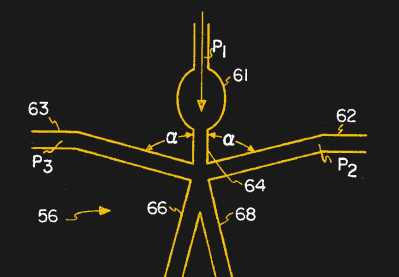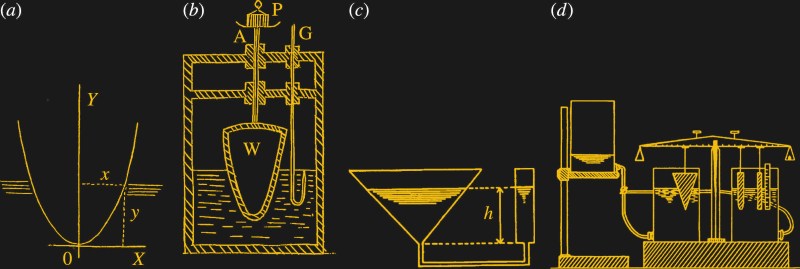Computers come in many forms, depending on your definition. We’ve seen computers and computer gates built out of things as diverse as marbles, relays, and — of course — transistors. However, there are logic gate systems that use a property of moving fluids to form logic gates and a bistable element. That’s all the pieces you need to build a working computer.
It may sound far-fetched, but there have been general-purpose computers built using this technology. It is also used in specialized applications where fluids are already flowing, like shower heads, automotive transmissions, and in places where electronics are prone to misbehave. Many think the field will see a resurgence when we need to build logic at the molecular level for nanotech applications, too.
Basics
In its most basic form, a fluidic gate uses flow as a logic 1 and less flow to be a logic 0. Merging two streams together provides an OR gate. Using a supply stream that you can divert with a control stream provides a NOT function. Given enough inverters and OR gates, you can build everything else.

However, the most effective fluidic logic gate is a bistable element sometimes known as a fluidic amplifier. This is analogous to an RS flip-flop. A supply flow feeds the device and two pressure ports provide inputs. If pressure appears on one port, the flow will continue out of one of two output ports. If pressure appears on the other port instead, the flow will continue out of the opposite port.
These flip-flops are designed in a Y shape with the control ports just before the branch. A smaller amount of pressure from the control ports makes the fluid “stick” to one wall or the other and, thus, prefer going on one side of the Y versus the other.
History
Nikola Tesla developed a fluidic diode in 1920. In 1949, an economist from New Zealand, Bill Phillips, wanted to model the economic processes of the United Kingdom and with computers difficult to access and not very powerful, he turned to a fluidic computer he built called MONIAC.
The computer used water tanks to represent different parts of the economy. The topmost tank was the treasury, and altering valve positions let you spend money at different rates and watch the effect. The prototype cost about £400 (about £15,000 pounds today) and was built from scrap. In total, somewhere around a dozen machines were eventually built, mostly by schools that appreciated how the model was understandable visually. There is a working replica in the New Zealand Reserve Bank as an exhibit that you can see in the video below.
In reality, though, using water to represent mathematical quantities wasn’t a new idea. In 1901, Arnold Emch proposed using particularly shaped weights to compute powers by measuring the amount of water displaced. Using water as an analogy for integration is also an old idea and “hydraulic calculators” were available in the 1930s to perform integration for specialized tasks and saw reasonably wide adoption in Russia up until the 1980s.
The idea came up again in 1957 when an Army lab realized that flue gasses could be directed down one of two pathways. And this led to the “fluidic amplifier” flip-flop that we mentioned above. Univac built a prototype FLODAC computer in 1964 to show how it might work.
Those amplifiers are what allow for what we think of as logic gates. Of course, they aren’t very fast, but they are very robust compared to, say, relays, or electronic devices that are sensitive to noise, static discharge, and vibration problems. Some experimental aircraft, like BAE’s MAGMA unmanned aerial vehicle, use fluidic thrust vectoring to control jet exhaust, something that might be hard to do with a 555. So even if your desktop computer’s water consumption will be limited to cooling, there are applications where it would be hard to do it any other way.
As we make tiny things where electrons don’t behave, we may see these methods get a new lease on life. Also, Rice and Harvard Universities have been using fluidics to build robots, and you can see what they are up to in the video below.
We’ve looked at water adders before. Turns out, you can make logic gates out of almost anything.

















While reading this, I wondered how these techniques could be used to increase the station life of a Venus lander; using some mechanical or fluid logic instead of electronic gates. Instead of water or hydraulic fluid, a melted metal such as lead or tin for the circuitry. Due to complexity only a few functions closer to the exterior of the lander might buy a little more time for the science to be accomplished.
Vacuum tubes might work in Venusian atmosphere even better than on Earth, because heaters can just be connected to outside temperature :) Capacitors with glass insulators would work too. Resistors can be made from resistive wire. Battery? Solar cells might work because they are made from silicon?
When I was just getting into the business, I worked with an older guy who did some of the engineering at Oak Ridge during the war and he would tell me about the unique issues they had in some of the intense radiation environments.
Apparently, certain types of radiation play poorly with the vacuum tube circuits of 1944 and there were spots where he and his colleagues had to work around this by building control systems out of pneumatic and hydraulic components instead of tubes. He said with a little thought you could build very complex very logic functions, sequencers and even PID controllers.
“He said with a little thought you could build very complex very logic functions, sequencers and even PID controllers.”
That was the way to do it for a long time (I think in HVAC) until digital technology became cheap enough to replace it. First time I heard about the pneumatic PID was around 2005 and my professor was insisting that those are still in use in maritime. But I am more than sure that it is still in use:
https://control.com/textbook/closed-loop-control/pneumatic-pid-controllers/
It is good and beautiful to diversify our technologies instead of relying on electricity only.
Automatic transmission.
https://medium.com/@stefan.sahagian/the-water-computer-and-you-4f4438ab313d
Thank you for that. I remember lerning about how valve bodies control automatic transmissions (c. 1970). Thought what marvelous devices — measuring speeds and comparing pressures and making ‘decisions’ about which gear to be in. In class they never used the word computer, but thought it remarkable and astounding when I realized that they were truly hydraulic computers.
Closest live example most will encounter, and with shop CNC and 3D printing recreate. Software may be the biggest issue to doing so.
Kinda related, and I think this may have been covered here, but you can also make light-based computers with logic gates made from old nightlights that turn on when their photoresistor notices it’s dark. That’s a NOT chip right there, and if you stick two nightlights next to a third, so it gets fired if either one of them goes on, there’s your NOR. A bunch of nightlights in a circle provide your clock, and you have a small computing device you can trigger with switch-operated lightbulbs as inputs. I never went much further than a clocked full adder because getting 110V to all of them gets complicated, but it was fun to play with.
I had this very idea a few years ago, and I’m glad to know someone has actually tried it (and succeeded, from the sound of it).
Now, the Internet can LITERALLY be a series of tubes.
To search a fluid-based system, do you use gurgle?
Just hope they don’t throttle your connection
Cutting off a competitor’s air-supply has a new meaning.
tried to boot one, but it only gets to the splash screen … the processor runs so hot I think it is just vaporware
At one point in the mid 80’s electronic controls were not allowed on dragsters, so some teams tried fluid based analog computers that ran the throttle and clutch. It also did wheel slip detection.
Instead of driving the working fluid into your system using pressure, what if you were to draw the fluid out the other side? For example, using the natural pressure of the atmosphere to drive air into the works? I think technically you could call these “vacuum tubes”, couldn’t you?
Artem plays with fluid logic these days :-)
https://www.youtube.com/c/ArtemKashkanov/videos
I think the more interesting applications for fluidic computing are the analogue ones, much like the macroeconomic demostration above and the number of differential engines built to solve soil freezing calculations by both the US and Soviets.
https://archive.org/details/ACFELANALYTICALSTUDIESOFFREEZINGANDTHAWINGSOILS1953/LUKYANOV%20-%20Hydraulic%20Apparatus%20for%20Engineering%20Computations%20%281955%29/mode/2up
I think Tesla uses a version of this to direct air flow from its climate control vents—two air streams to direct the flow up or down depending on differential flow rates.